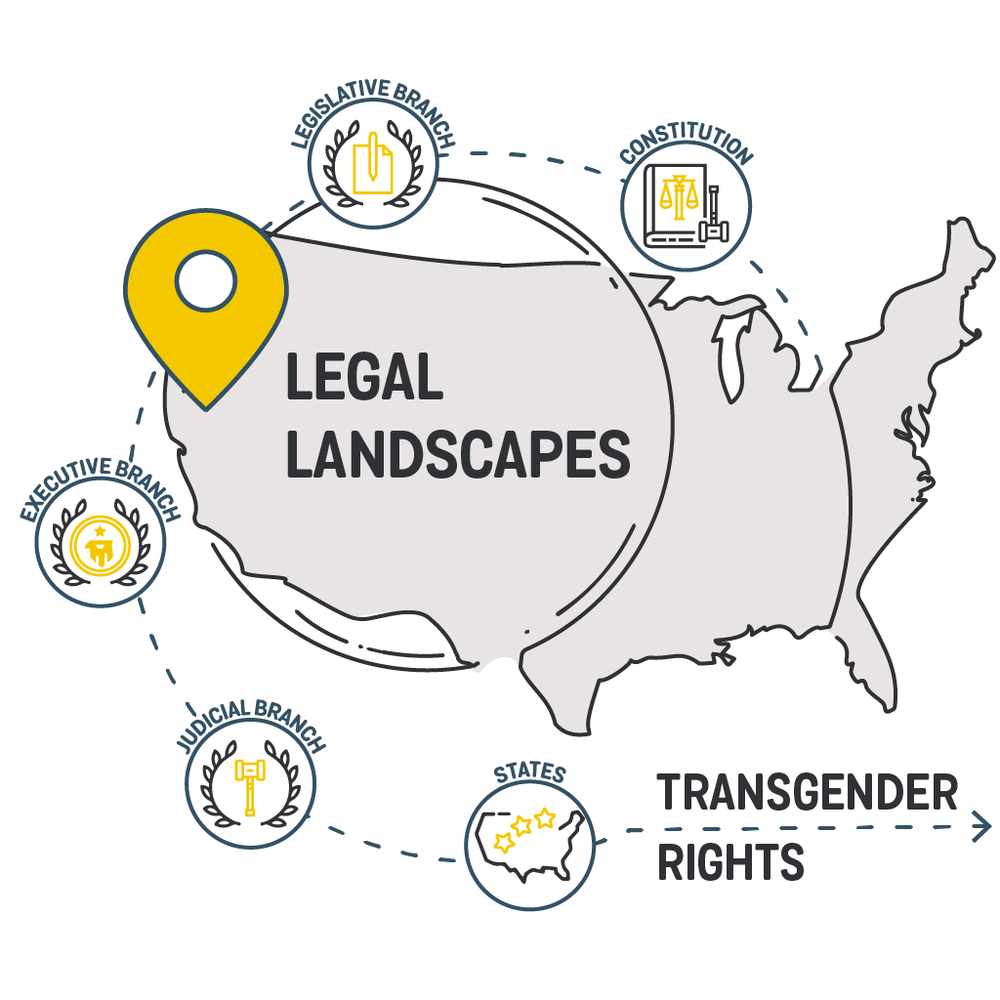
United States History and Laws Relating to Transgender Rights
Constitution • Congress • Executive • Federal Courts • State Governments
Introduction
While the American Constitution prevents discrimination on the basis of race, color, religion and national origin, the protections do not apply against discrimination based on sexual identity and sexual orientation. Transgender issues weren’t on the radar at the time. As such, transgender people (comprehensive list of transgender terms) have continued fighting for equal protection in regards to housing, employment, medical and civil rights. Their struggles continued past the time that women gained recognition under the law and after the civil rights movement during which minorities became more successful in asserting their rights.
In this Legal Landscape, we will explore the history of transgender rights in the United States and describe the relevant laws and regulatory actions.
U.S. Timeline
- 1959: Christine Jorgensen, a transgender woman, is denied a marriage license in New York on the basis of her birth gender.
- 1975: Minneapolis became the first city in the United States to pass trans-inclusive civil rights protection legislation.
- 1975: In Darnell v. Lloyd, a Connecticut court found that substantial state interest must be demonstrated to justify refusing to grant a change in sex recorded on a birth certificate.
- 1976: In M.T. v. J.T., the Superior Court of New Jersey rules that transgendered persons may marry on the basis of their gender identity, regardless of their assigned gender.
- 1977: Renee Richards, a transgender woman, was granted entry to the U.S. Open after a ruling in her favor by the New York Supreme Court in Richards v. US Tennis Assn.
- 1989: Ann Hopkins is denied a promotion on the basis that she is not, in the opinion of management, sufficiently feminine. She sues and the case reaches the Supreme Court. In Price Waterhouse v. Hopkins, the Court rules that gender stereotyping can form the basis of a Title VII sex-discrimination complaint.
- 2002-2003: Early transgender rights groups begin forming, including: the Transgender Law Center, Sylvia Rivera Law Project and National Center for Transgender Equality.
- 2008: First ever U.S. Congressional hearing on discrimination against transgender people in the workplace was held by the House Subcommittee on Health, Employment, Labor, and Pensions.
- 2010: The Obama administration explicitly banned gender identity-based discrimination on federal job descriptions.
- 2014: President Obama signed Executive Order 13672, adding “gender identity” to the categories protected against discrimination in hiring in the federal civilian workforce and both “gender identity” and “sexual orientation” to the categories protected against discrimination in employment and hiring on the part of federal government contractors and sub-contractors.
- 2016: Obama administration issued guidance that directed public schools to let transgender students use bathrooms and locker rooms matching their gender identity, and to use the student’s preferred name and pronouns.
- 2017: Trump administration overturned the Obama administration’s guidance in regards to public schools.
- 2017: Education Department gave a memo to staff declaring that the lawyers of the Office for Civil Rights must consider the discrimination complaints of transgender students on a case-by-case basis, and that that office cannot rely on the Obama administration’s guidance in determining how to answer complaints by transgender students.
- 2017: Rep. Pete Olson [R-TX] introduced federal legislation which would limit gender identity to biological assignation, known as the Civil Rights Uniformity Act of 2017. This bill would remove the ability to apply federal civil rights protections to transgender individuals.
References:
- GLAAD, Timeline: A Look Back at the History of Transgender Visibility.
- ThoughtCo, A History of Transgender Rights in the United States.
RECENT EVENTS
- The Obama administration issued guidance to protect the rights of transgender people during his term (2008-2016). The guidance mandated fair treatment in employment with the federal government, and protected transgender identity in schools.
- The Trump administration has been working against Obama-era protections for transgender individuals. For example, according to the New York Times, in October 2018 the Trump administration wanted to enact a legal definition of sex as “a biological, immutable condition determined by genitalia at birth.” The definition would keep transgender people from receiving civil rights protections (anti-discrimination) and various healthcare benefits. Trump already rolled back protections for transgender students (2017) and has been hostile towards transgender people serving in the military.
Legal Landscape
What laws relate to transgender rights?

The Constitution
The Constitution does not have any text specifically referencing transgender people. But some argue the 14th Amendment’s Equal Protection Clause applies: No state shall deny to any person “equal protection of the laws.”

Congress
Congress has not passed any laws specifically protecting transgender people. But some argue that laws preventing gender discrimination should apply to protect discrimination of transgender people. For example, the Civil Rights Act of 1964, Title IX says “No person in the United States shall, on the basis of sex, be excluded from participation in, be denied the benefits of, or be subjected to discrimination under any education program or activity receiving Federal financial assistance.”

The President and Executive Agencies
In 2014, President Obama issued an executive order prohibiting discrimination against transgender people in employment by the federal government and its contractors.
Also under Obama, the Department of Education and the Department of Justice issued a letter (executive guidance that was revoked by President Trump) interpreting the Civil Rights Act of 1964, Title IX that schools receiving federal funding (e.g. public schools) should respect gender identity, advising schools to use a student’s preferred name and pronouns and to allow use of bathrooms and locker rooms of the student’s gender identity. See Gloucester County School Board vs. G.G. in the Judicial section.

Federal Courts
A federal appeals court (Fourth Circuit Court of Appeals) ruled inGloucester County School Board vs. G.G.(2016)against a school board’s policy requiring students to use restroom and locker rooms of their assigned sex at birth, citing the executive guidance issued under Obama and then revoked by Trump. The Supreme Court planned to hear the appeal, but that was before President Trump revoked the guidance. The Supreme Court now is requiring the Fourth Circuit to revisit the ruling.
Supreme Court decided in Obergefell v. Hodges (2015) that the Constitution’s 14th Amendment guarantees all people (particularly transgender people and same-sex couples) the fundamental right to marry. The ruling means that states cannot issue laws, rules or take any actions to prevent same-sex marriage (thus had to strike any laws against it).

State Governments
Some states recognize and protect against discrimination of transgender people, but to varying degrees.
States may not prohibit same-sex marriage, due to Obergefell v. Hodges (see Judicial section).

